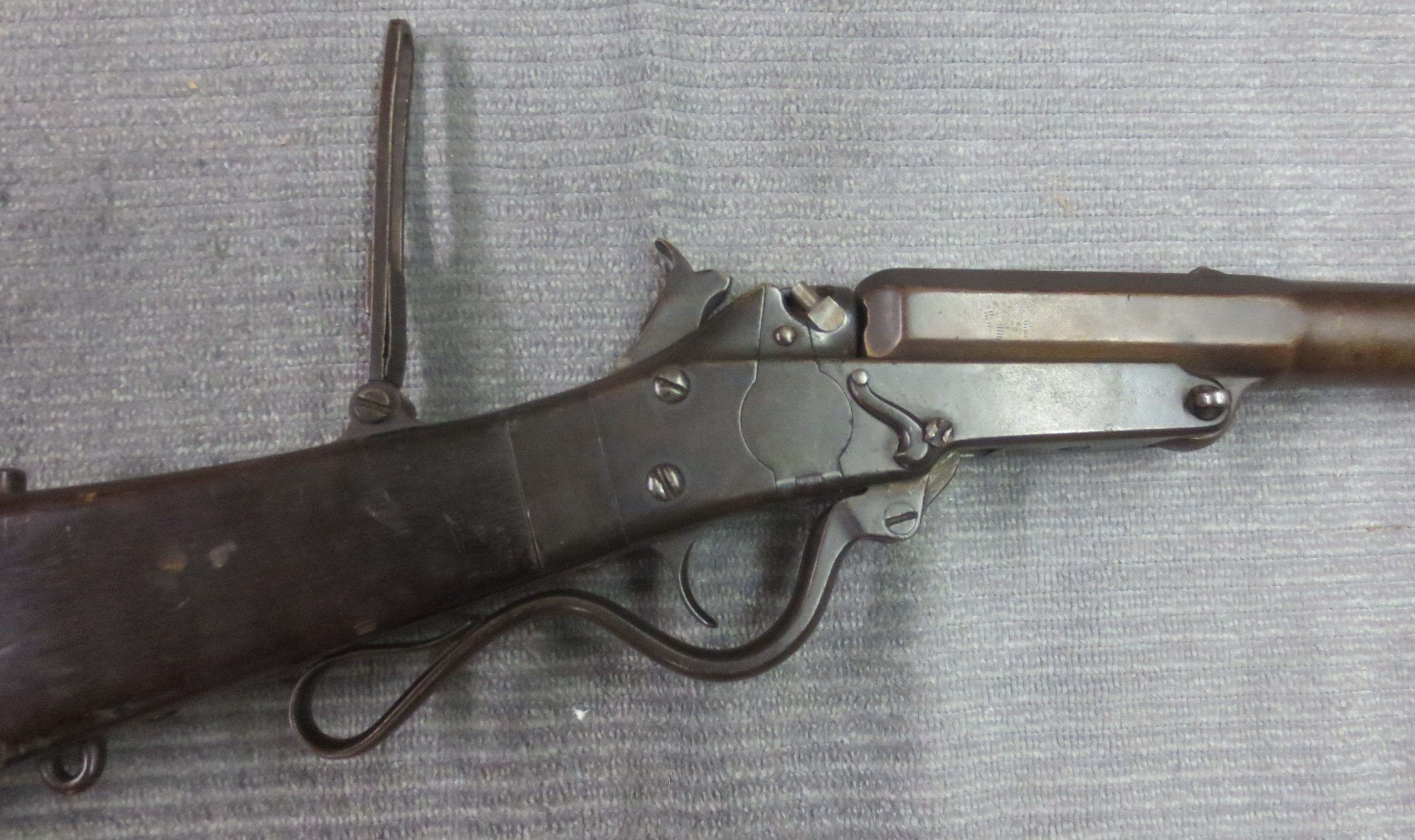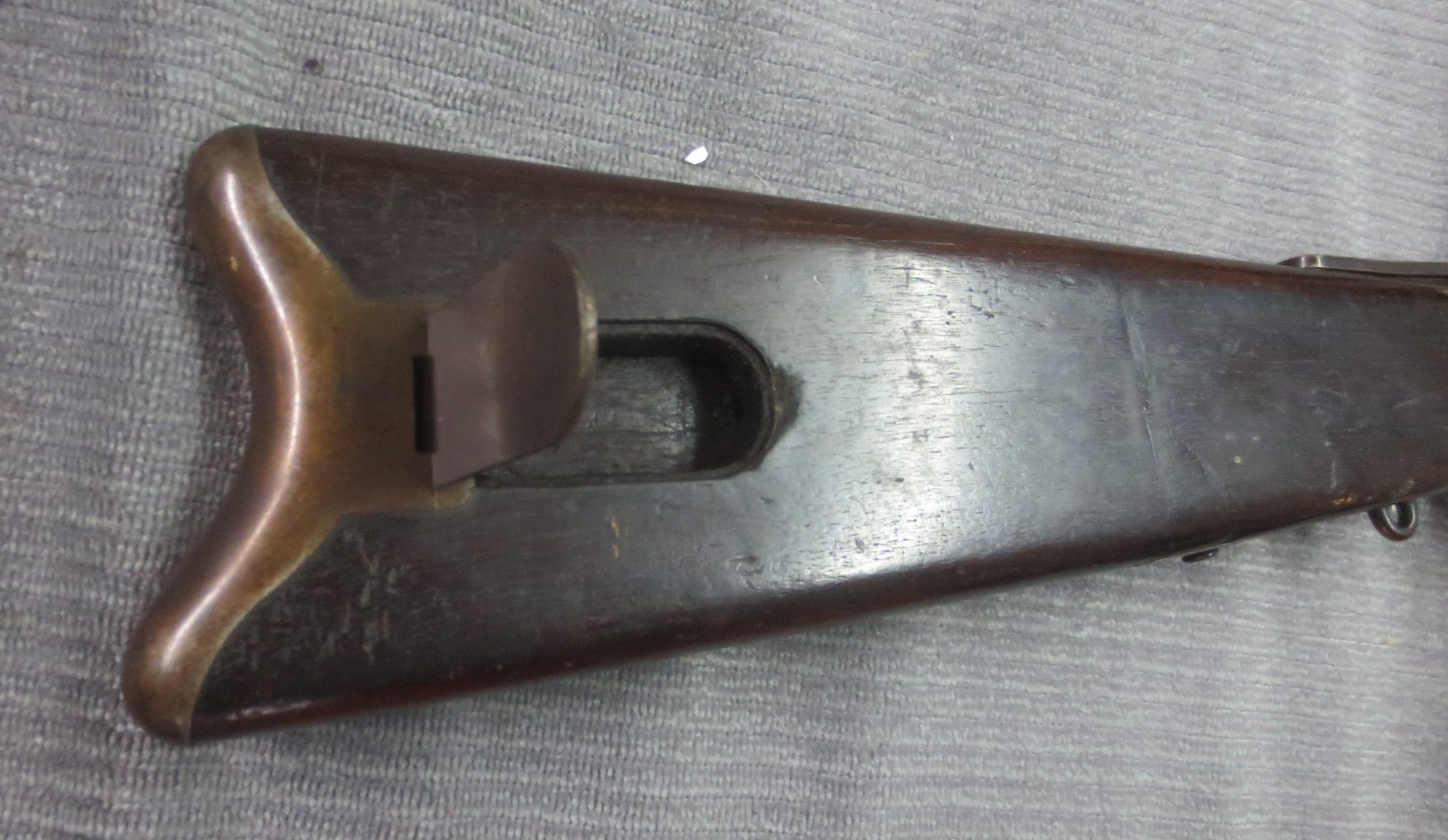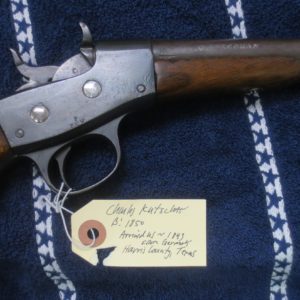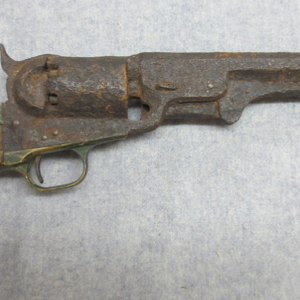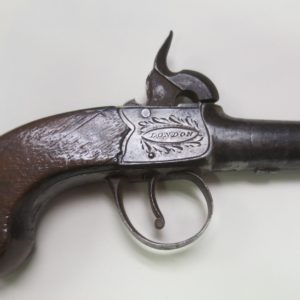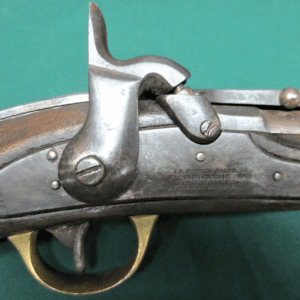Description
This is a GREAT example of the scarce and desirable 1st Model Maynard Carbine S/N 2068, smack dab in the known CONFEDERATE serial number range. These guns were the invention of dental surgeon and firearms innovator Dr. Edward Maynard, known for his invention of the Maynard Tape Priming System, an automated priming system that utilized a varnished strip of paper with small amounts of fulminate of mercury, similar to a modern day child’s cap gun. The system advanced the roll of primers each time the hammer was cocked, and upon firing, the hammer cut off the spent cap. This system showed such promise and was so well thought of by the US Ordnance Department that the US Government paid Maynard $75,000 for the use of his priming system on the US M-1855 series of arms.
Maynard paid the US Springfield Armory $116.37 in 1853 to produce a full scale model of his carbine and the model was tested by the Ordnance Department in 1856 with very positive results. The successful trials resulted in the formation of the Massachusetts Arms Company in 1857, which was formed for the purpose of producing Dr. Maynard’s breech loading long arm. The guns were produced in both carbine and rifle lengths, with 20” and 26” barrels respectively, and were offered in both .35 and .50 caliber.
According to arms researcher, author and historian James D McAulay, a number of famous (and soon to be famous) Southerners purchased the carbine pattern Maynard arms. These men included South Carolina’s Wade Hampton, Georgia senator Robert Toombs and Vice President John Breckenridge of Kentucky; all of who became Confederate Generals during the American Civil War.
The initial production goal of the Massachusetts Arms Company had been 5,000 arms. According to McAulay, as of October 1, 1860 the company had sold approximately 1,400 guns and had a total of 3,527 arms in inventory. The inventory on hand was distributed as follows:
326 2nd Quality Arms ; 459 .50 / 20” / Sporting; 676 .50 / 20” / Military; 142 .50 / 26” / Sporting; 160 .50 / 26” / Military; 1,326 .35 / 20” / Sporting: 425 .35 / 20” Military; and 13 .35 / 26” / Military
McAulay further notes that approximately 90% of this remaining inventory of 1st Model Maynard rifles and carbines were purchased by Southern states and militia companies between October 1, 1860 and April of 1861. The majority of the guns went to the states of Mississippi, Florida and Georgia. Florida acquired a total of 1,030 guns in December of 1860, all of which were carbine length (20”) and were chambered in .35 caliber.
Mississippi acquired 800 guns in December of 1860 as well. Their purchase included both carbines (625 total) and rifles (26” barrel, a total of 175) and the guns were a mixture of .50 and .35, with all 175 of the rifles and 300 of the carbines being .50 and the remaining 325 carbines being .35. All 650 of the Georgia purchased guns were all .50 caliber carbines. While Florida and Mississippi acquired their guns directly from the Massachusetts Arms Company, Georgia purchased their guns in January and March of 1861 from the firm of W.J. Syms & Brothers of New York City. Syms sold an additional 1,700 Maynards between October 1860 and May 1861. It is estimated that all but about 100 of these guns went to southern purchasers. McAulay notes that approximately 800 of these guns went South Carolina and Louisiana. The balance of the estimated 800 “Confederate” sales by Syms were apparently made to Kentucky and Tennessee in April and May of 1861. A substantial number of Confederate regiments were at least partially armed with 1st Model Maynard rifles and carbines during the Civil War, resulting in the guns (in both barrel lengths and calibers) being listed in the 1863 Confederate Ordnance Manual as a standard issue Confederate carbine. Some of the Confederate units armed with the guns included the 1st and 6th Florida Special Battalion of Infantry, 2nd Florida Cavalry, 5th & 9th Georgia Cavalry, Cobb’s Legion of Cavalry (Georgia), 1st Louisiana Cavalry, 11th Louisiana Infantry, 1st & 4th Mississippi Cavalry, 9th, 14th & 15th Mississippi Infantry, 18th North Carolina Infantry, 3rd Tennessee Cavalry, 35th Virginia Cavalry Battalion and the Waccamaw South Carolina Light Artillery. Some 1st Model Maynards were also issued to the Confederate ironclad CSS Atlanta. The production of the 1st Model Maynard was brought to an end by a fire at the Massachusetts Arms Company factory in January of 1861. Dr. Maynard proceeded to buy out all of the various partners and owners of the company in 1862 and by 1863 the factory was back in business, producing the 2nd Model Maynard Carbine for the US Ordnance Department.
This particular 1st Model Maynard Carbine is in about VERY GOOD+ condition overall. The gun is a 20” barreled, .35 caliber, military configuration carbine. The gun is 100% complete and correct, with the exception of damage to the hammer as shown. The action of the carbine remains crisp and tight and is clearly marked in two lines on the lower right side of the frame: MAYNARD ARMS CO. / WASHINGTON. It is additionally marked on the lower left side of the frame: MANUFACTURED BY / MASS. ARMS CO. / CHICOPEE FALLS and on the patchbox door: MAYNARD PATENTEE / SEP 22 1845 / MAY 27 1851 / JUNE 17 1856. The carbine is serial number 2068 and is clearly marked with that number inside the tape primer door and on the bottom of the barrel (concealed by the frame).
There is some light peppering and minor pinpricking around the breech area and near the percussion bolster, all from the caustic mercury in the primer pellets. The barrel retains only some minor traces of blue in the protected areas under the breech. The balance of the 20” octagon to round barrel is a light gray to plum-brown patina and there are some small, scattered patches of minor peppering and pinpricking along the length of the barrel. The gun is in the “military” configuration and is equipped a loop for a 1” sling ring on the rear of the trigger plate tang. It also has the military sight package, which included both the flip up, long-range tang sight and the fixed “quick acquisition” rear sight on the breech of the barrel. The bore of the carbine is in very good to fine condition. One of the unique features of the 1st Model Maynard carbine was the ability to adjust the headspace of the gun by adjusting the relationship between the barrel breech and rear of the frame. The buttstock is in VERY FINE condition and is solid and free of any breaks, cracks or repairs. The buttstock shows the usual minor bumps and dings from handling and use, but shows no abuse or damage.
Overall this is a really wonderful, rare, complete and extremely attractive example of a likely CONFEDERATE 1st Model Maynard Carbine. The gun is in the most desirable of all 1st Model Maynard configurations, the .50 caliber, military carbine. The gun is almost certainly a Confederate purchased arm and either went to Florida, Mississippi, or Georgia. 1st Model Maynard carbines do not appear on the market very often and when they do the price usually starts in the $5,000+ range and quickly climbs.

